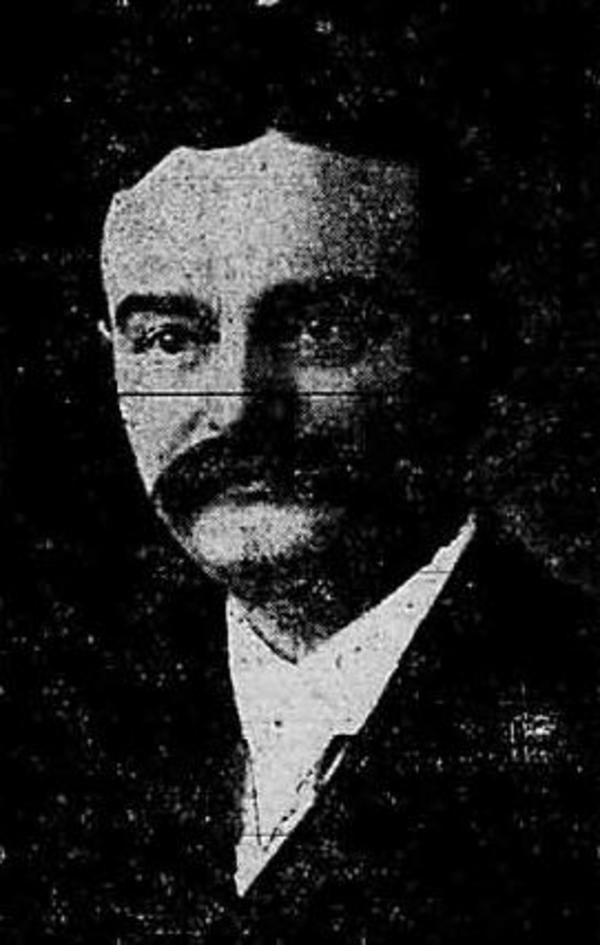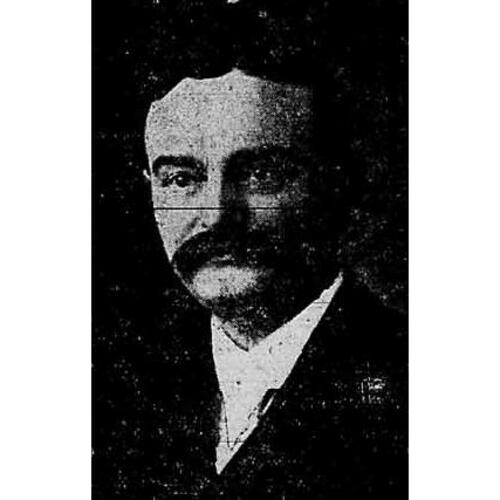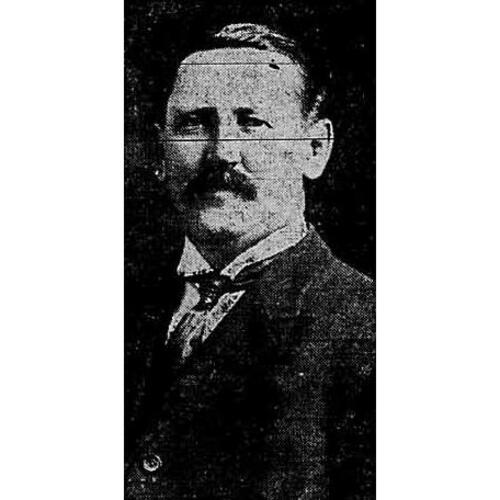
Source: Courtesy of Wikimedia Commons
BLOW, Thomas Henry, medical doctor, businessman, and politician; b. 22 Jan. 1862 in South Mountain, Upper Canada, son of Robert Hutchinson Blow and Sarah Henderson; m. 18 June 1895 Ida Jane Mulholland (1866–1943) in South Mountain, Ont., and they had two sons and two daughters; d. 27 Dec. 1932 in Vancouver and was buried in Calgary.
Thomas Henry Blow was born and raised in South Mountain, in the Ottawa valley about 30 miles south of the Canadian capital. His father owned a carriage works in the village, where as a youth Thomas would be employed building, upholstering, and painting vehicles. Robert Blow had come from County Armagh (Northern Ireland), and Thomas’s mother was a native of South Mountain itself. Raised a Presbyterian, Blow never smoked or drank. On account of his parents’ poor health, he supported the family after finishing his primary education at age 13. When an opportunity arose many years later to attend high school in neighbouring Kemptville, he took it. He was 28. The gifted young man completed the entire program in a single year.
In 1891, having passed his matriculation exam, Blow entered medical school at McGill University in Montreal. In the year of his graduation, 1895, he married Ida Mulholland in South Mountain. That summer he also passed the state medical examinations in Colorado. His movements over the next few years are uncertain. In London, England, and Edinburgh he pursued postgraduate training in the diseases of the eye, ear, nose, and throat; he is known to have spent about a year in Denver at some point; and it is also thought that he exercised his profession briefly in Ottawa. In 1903 he relocated to Calgary. According to his obituary in the Journal of the Canadian Medical Association, he was the first physician in the city to focus on the eye, ear, nose, and throat. Dr James Wilson Richardson, a younger colleague, would recall that Blow gained enormous respect in his field. His services were in demand throughout southern Alberta, and in parts of Saskatchewan and British Columbia.
Blow’s younger son, Donald Mulholland, would later describe his father’s medical practice in Calgary. Dr Blow established his offices, examination rooms, and a small operating theatre in a section of the family’s brick home. His principal specialization was the eye, and he administered the majority of tests for colour blindness and other problems required by the Canadian Pacific Railway Company in Calgary. A compassionate man, he often declined to charge if a client could not afford a doctor. Despite the many demands on his time, Donald remembered, his father managed to play hockey and baseball with his children. He loved the outdoors. Every fall he took Donald out of school (as he had likely done with his other son, the elder by ten years) and they went duck hunting for two weeks.
Upon his arrival in southern Alberta, Blow had become heavily involved in real estate. He constructed a warehouse and several business blocks in downtown Calgary. In the 1910s the entrepreneur built and operated a theatre, the Princess, adjacent to the city hall. By 1906 his parents, his brother, an unmarried sister, and his wife’s parents had also settled in Calgary. The city was growing rapidly at this time, its population rising tenfold from slightly over 4,000 to more than 40,000 between 1901 and 1911. Blow worked with his father and brother, a real-estate agent, in the buying and selling of farmland. When an economic crash occurred just before the outbreak of World War I, Donald recalled, his father was somehow able to avoid major losses.
Blow had a strong predilection for politics. In 1909 he ran provincially for his lifelong party, the Conservatives, who were then in opposition. He lost, but he won the seat of Calgary South by a landslide in 1913 and was re-elected handily four years later. While not a strong, eloquent speaker, he gained respect for his devotion to his constituents and his knowledge of the province. When George Hedley Vicars Bulyea* retired as lieutenant governor in 1915, it was rumoured that Blow might succeed him, and he was subsequently thought a likely replacement for Edward Michener*, who resigned in 1918 as leader of the provincial Conservatives; in the end, these positions went to others. Blow left politics after his defeat in the election of 1921.
Much of his political interest came from his love of education. He had actively promoted the founding of Mount Royal College, an elementary and secondary school that opened in 1911, and served on its board of directors. His principal focus, however, was the creation of a university in Calgary. In 1907 the University of Alberta had been established with provincial money at Strathcona (Edmonton). Within a few years Blow and other Calgarians began to argue for a privately financed institution of higher learning in their city, and in 1910 he became chair of the board of governors of the proposed University of Calgary. His great ally in this project was local farmer and politician William John Tregillus*, who gave a large tract of land as well as a substantial grant of money to the project. The promoters wanted the institution to be privately funded so as to be free of “political affiliations.” They believed that its establishment would assist business in southern Alberta by increasing land values and encouraging trade. The training of scientific and technical experts would also help with the exploitation of the area’s forests, minerals, and farmland. Finally, a university in Calgary would allow local children to obtain higher education in their own city.
Henry Marshall Tory*, the founding president of the University of Alberta, opposed the idea from the beginning. The province, he stated, could afford only one institution capable of first-rate research and teaching. Concurring, the legislature declined to endow the proposed institution with degree-granting powers, and thus it was Calgary College that Blow and others incorporated in 1910. By 1912 its promoters had acquired some 600 acres of land and claimed that subscriptions had reached $500,000; $40,000 in property and money came from the doctor himself. Having managed to attract a well-qualified staff, the college began classes in October 1912 in the new Calgary Public Library; however, continued legislative opposition to the bestowal of university status, the collapse of the real-estate market in 1913, and a rapid decline in enrolment after war was declared the following year would put an end to Calgary’s hope of a privately financed university. In May 1914 the provincial government of Arthur Lewis Watkins Sifton* appointed a three-member commission composed of the presidents of Dalhousie, Toronto, and Saskatchewan universities “to consider the granting of degree-conferring powers to Calgary College.” They recommended in December that the University of Alberta remain the only university in the province but that a publicly funded provincial institute of technology and art be established in Calgary. Blow’s college closed its doors in the late spring of 1915.
In the legislature the great champion of higher education in Calgary kept up the struggle, agitating for the implementation of the commission’s recommendation of a technological institute. The province in February 1916 agreed to equip and maintain the building that the city of Calgary itself would eventually erect; the facility opened in temporary premises that October. When the cornerstone of the Provincial Institute of Technology and Art was laid on 22 June 1921, the energetic doctor’s contribution to its founding was acknowledged by Premier Charles Stewart* and others. Perhaps he had failed to win a university for Calgary, but he had helped to obtain the consolation prize, the establishment known since 1960 as the Southern Alberta Institute of Technology.
Thomas Henry Blow died of a heart attack in Vancouver, where he and his wife had gone because of the illness of their younger daughter.
Thomas Henry Blow is the author of “Why the University of Calgary should not become part of the University of Alberta,” Morning Albertan (Calgary), 31 May 1913: 13.
GA, M 1543-519, E. E. Braithwaite and T. H. Blow to A. E. Cross, 26 March 1912; M 9151, interview by H. C. Klassen with Donald [M.] Blow, 26 April 1975 (transcript). LAC, RG 150, Acc. 1992–93/166, box 829-10. Calgary Eye Opener, 23 Oct. 1915. “City loses a fine citizen,” Calgary Herald, 28 Dec. 1932: 4. “Dr. Blow, m.l.a., mentioned for Lieut.-Governor,” Calgary News Telegram, 23 Aug. 1915. “Dr. Blow death causes sincere regret in city,” Calgary Albertan, 28 Dec. 1932. “Dr. Blow’s motion to give Calgary university lost,” Calgary Herald, 6 April 1921. D. B. Smith, “Calgary university’s fight 75 years old,” Calgary Herald, 3 Oct. 1987. “A sound candidate,” Calgary News Telegram, 4 June 1917. “Technology school corner-stone is laid with much ceremony,” Calgary Herald, 23 June 1921: 6. “Theater owner complains of business tax,” Calgary News Telegram, 31 Jan. 1917. Alta, Chief Electoral Officer, A report on Alberta elections, 1905–1982 ([Edmonton, 1983?]). John Blue, “Thomas Henry Blow, m.d.,” in his Alberta, past and present, historical and biographical (3v., Chicago, 1924), 2: 480–84. Max Foran, with Edward Cavell, Calgary: an illustrated history (Toronto, 1978). G. E. Learmonth, “Dr. Thomas Henry Blow,” Canadian Medical Assoc., Journal (Toronto), 28 (1933): 227. N. L. McLeod, “Calgary College, 1912–1915: a study of an attempt to establish a privately financed university in Alberta” (phd thesis, Univ. of Calgary, 1970). A. O. MacRae, History of the province of Alberta (2v., [Calgary], 1912), 2: 636–38. Rosalie Pedersen, Technically, an experiment: the history of the Southern Alberta Institute of Technology (Calgary, 1991). Anthony Rasporich, Make no small plans: the University of Calgary at forty ([Calgary], 2007). D. B. Smith, “Will Tregillus: an Alberta booster a century ago,” Alberta Hist. (Calgary), 58 (2010), no.3: 2–10.
Cite This Article
Donald B. Smith, “BLOW, THOMAS HENRY,” in Dictionary of Canadian Biography, vol. 16, University of Toronto/Université Laval, 2003–, accessed December 31, 2025, https://www.biographi.ca/en/bio/blow_thomas_henry_16E.html.
The citation above shows the format for footnotes and endnotes according to the Chicago manual of style (16th edition). Information to be used in other citation formats:
| Permalink: | https://www.biographi.ca/en/bio/blow_thomas_henry_16E.html |
| Author of Article: | Donald B. Smith |
| Title of Article: | BLOW, THOMAS HENRY |
| Publication Name: | Dictionary of Canadian Biography, vol. 16 |
| Publisher: | University of Toronto/Université Laval |
| Year of publication: | 2020 |
| Year of revision: | 2020 |
| Access Date: | December 31, 2025 |




